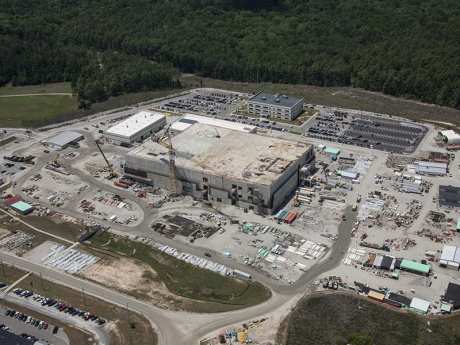The USA's partially built Mixed Oxide Fuel Fabrication Facility (MFFF), a key component of the country's plutonium disposition program, is to be placed on cold standby after being effectively cut out of the Department of Energy's (DoE's) FY2015 budget request.
 |
| MFFF, pictured in May 2013, with the exterior structure of the facility complete (Image: Shaw Areva MOX Services) |
The DoE's $27.9 billion budget request includes $11.7 billion for the US National Nuclear Security Administration (NNSA), the body responsible for US non-proliferation activities including the plutonium disposition program as well as the maintenance of the nation's nuclear arsenal. That arsenal now needs extensive - and expensive - modernisation to keep it safe. Of the $11.7 billion the DoE has requested for NNSA, the lion's share - $8.3 billion - is earmarked for its weapons activities appropriation, including $2.7 billion for stockpile modernisation. The MFFF receives nothing.
The MFFF is being built by Shaw Areva MOX services to fulfil the USA's commitments under a bilateral agreement with Russia, in which both countries have committed to dispose of some 34 tonnes of weapons-usable plutonium into mixed oxide (MOX) fuel for use in civilian nuclear reactors. Work started on the plant at Savannah River, South Carolina, in 2007, with a 2016 startup envisaged. Although based on France's Melox MOX facility, the MFFF project has presented many first-of-a-kind challenges and in 2012 the US Government Accountability Office (GAO) suggested it would likely not start up before 2019 and cost at least $7.7 billion, far above original estimates of $4.9 billion.
The project has seen progressive cuts to its budget, with only $320 million requested for the facility in the 2014 budget reflecting a slowing down of construction and associated activities as the NNSA embarked a review of its plutonium disposition strategy.
The FY2015 budget request cites the anticipated cost overrun as its reason for suspending the MOX facility project. "As part of an ongoing analysis of options to dispose of US surplus plutonium, it has become apparent that the MFFF will be significantly more expensive than anticipated, and therefore, the budget request places the MOX facility in cold stand-by while the department evaluates plutonium disposition options," the budget request states. The costs of putting the project on cold standby will come from the $1.6 billion set aside in the budget request for NNSA's nuclear non-proliferation activities.
Areva Inc says that the cold standby decision is a euphemism for the termination of the project. In a press release, the company said that by dropping the project from the budget the DoE was effectively calling for a cessation of a previously approved program. "We note that the NNSA says it conducted a 'year-long review' of the project that they say may provide alternatives more quickly and cost effectively, and for this reason the MOX project will be stopped. However, we have not seen the results of this review, but we would welcome the opportunity to do so," Areva Inc said.
Mixed signals
In addition to the $11.9 billion requested for NNSA, DoE's FY2015 budget includes $863 million for the Office of Nuclear Energy, for ongoing research and development in advanced reactor and fuel cycle technologies as well as the DoE's small modular reactor (SMR) licensing technical support program, for which $97 million is set aside.
US nuclear industry representatives said that the overall budget sent "mixed signals" on nuclear energy. Alex Flint, senior vice president for governmental affairs at the US Nuclear Energy Institute (NEI), praised DoE's ongoing support for small reactors and the inclusion of $79 million for activities to advance its used nuclear fuel management program but questioned proposals to impose taxes on nuclear energy companies to finance the cleanup of DoE enrichment facilities in Kentucky, Ohio and Tennessee. Regarding the MFFF, the NEI questioned any abandonment of the project, saying that to do so would leave plutonium in a weapons-usable state for the foreseeable future. "The ongoing construction of the MOX fuel fabrication facility at Savannah River Site - now 60% complete - should be finished, not placed into 'cold standby'", Flint said.
Researched and written
by World Nuclear News




_18570.jpg)
_16159.jpg)
_18938.jpg)
_33584.jpg)





